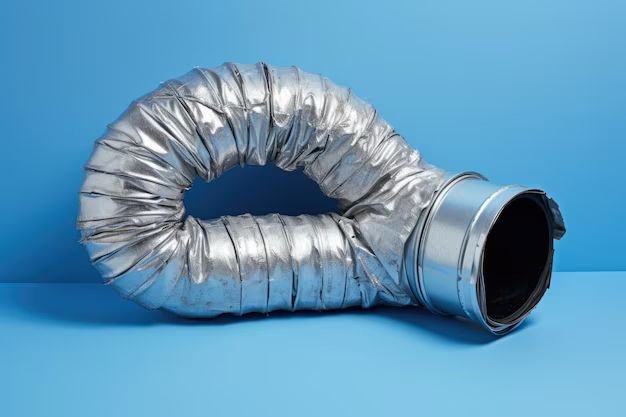Page Contents
What is a recessed dryer vent?
A recessed dryer vent is a vent that is installed into a wall cavity rather than on the exterior wall surface. This creates a flush, built-in look rather than having the vent visibly sticking out from the wall. Recessed dryer vents are often used for aesthetic purposes in modern, streamlined laundry rooms.
Some key features of recessed dryer vents:
– Installed between wall studs inside the wall cavity.
– Vent cover is flush with the wall surface for a streamlined look.
– Requires proper framing of the wall and drywall work to install.
– More complex installation than standard surface-mounted vents.
– Often requires a duct extension piece to connect the recessed vent to the dryer.
Pros of recessed dryer vents
There are a few potential advantages to using a recessed dryer vent rather than a standard surface-mount vent:
Aesthetics
The main benefit is strictly aesthetic – recessed vents provide a cleaner, more integrated and modern look compared to surface-mounted vents. This can be desirable in contemporary, finished laundry rooms where a flush wall surface is preferred. The vent is essentially “hidden” for a seamless appearance.
Space saving
Recessed vents don’t protrude from the wall, which can allow placing washers and dryers closer to the wall to save space in a laundry room. This extra inch or two can be beneficial for small or tight laundry areas.
Durability
When installed properly, a recessed vent may be less susceptible to damage or accidental bumps than a surface-mounted vent. Being flush with the wall makes it less prone to dings, dents or other issues.
Weather protection
With no portion sticking out from the wall, a recessed vent may provide slightly better protection from rain, snow or wind. Surface-mounted vents are more exposed to the elements.
Cons of recessed dryer vents
However, there are also some downsides to consider with recessed dryer vents:
Higher installation cost
The main drawback is a more complex, labor-intensive installation process, which also makes recessed vents more expensive to install. Modifying the wall framing, drywall and finishing work adds cost.
Harder to clean lint
Since the vent is buried inside the wall, it can be harder to access the interior ductwork to clean out lint buildup. This is an important maintenance task for fire safety.
Requires duct extension
An extension duct piece is usually required to connect the recessed vent to the dryer. This adds material cost and reduces airflow efficiency.
Moisture issues
Being installed within the wall cavity, any leaks or moisture issues with the vent or ductwork could cause mold and mildew problems inside the wall itself. This is not visible or easily addressed.
Wall structural issues
Cutting a hole in the wall studs can potentially impact the wall’s structural integrity and require additional framing for support. Proper planning is vital.
Key factors when deciding on a recessed vent
If you’re deciding between a recessed or standard surface-mounted dryer vent, there are a few key factors to keep in mind:
Laundry room location – Recessed vents make the most sense for interior laundry rooms rather than exterior walls. For laundry rooms on an exterior wall, a flush-mounted vent cover can still provide a clean look.
Budget – The higher installation cost of $200-500 (vs. $50-150 for surface-mounted) should be factored into your budget. Overall vent cost will be 2-3 times higher.
Wall framing – Your home’s wall framing must accommodate a recessed vent. Installing on an exterior wall or between two studs is easiest.
DIY skills – If tackling a recessed vent as a DIY project, ensure you have the drywall, framing and finishing skills required. Hiring a pro is recommended.
Aesthetic goals – A recessed vent only makes sense if the cleaner, flush look is your main priority. It’s not needed functionally.
Maintenance needs – Recessed vents require more planning to clean lint buildup from ducts. Access doors can help provide maintenance access.
Recessed vent installation tips
If installing a recessed dryer vent, here are some tips to do it right:
– Consult building codes for proper vent size, materials and configuration. Do not compromise on vent diameter – 4 inches is recommended minimum.
– Carefully measure and frame the opening between studs. Adequate framing is crucial for structural support.
– Use galvanized rigid metal ductwork, not flexible vinyl. Rigid duct reduces lint buildup and fire risks.
– Connect vent to dryer using a short metal extension duct piece, not flexible vinyl.
– Use vent manufacturer’s specific framing and installation instructions.
– Seal all joints thoroughly with approved vent tape to prevent moisture intrusion.
– Consider installing an access panel for easier cleaning and lint removal.
– Use proper protective duct terminations and covers made for recessed vents.
– Hire an experienced professional if you don’t have the needed drywall, framing and finishing skills.
Conclusion
Recessed dryer vents can provide a modern, seamless look in your laundry room. However, the higher installation cost and potential downsides need to be carefully weighed against the aesthetic benefits. They only make sense for certain situations where the flush appearance is highly desired. For straightforward vent functionality alone, a basic surface-mounted vent often suffices and keeps costs down. As with any customized home improvement project, planning properly ahead of time and hiring experienced installers is key to success.
